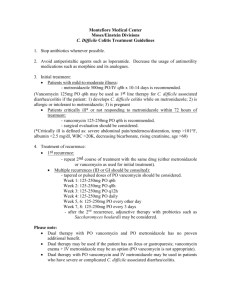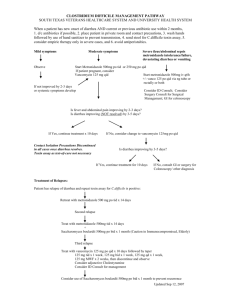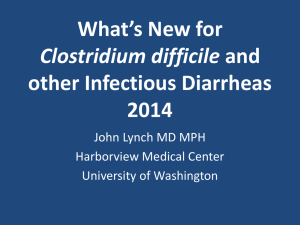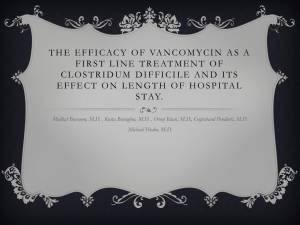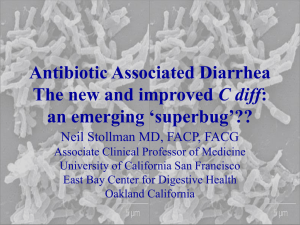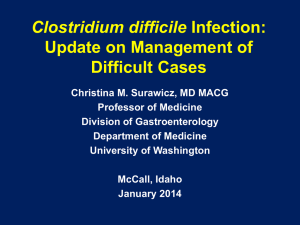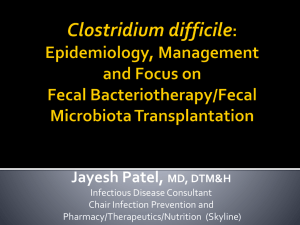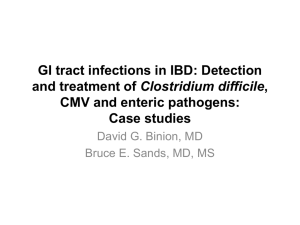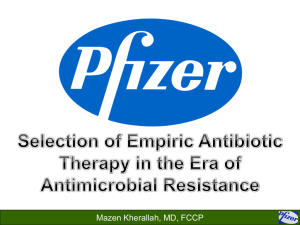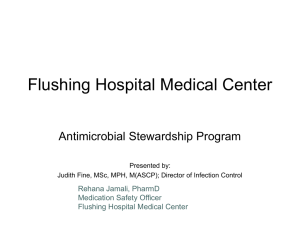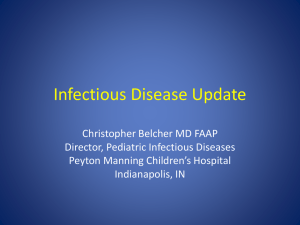C difficile - MCE Conferences
advertisement
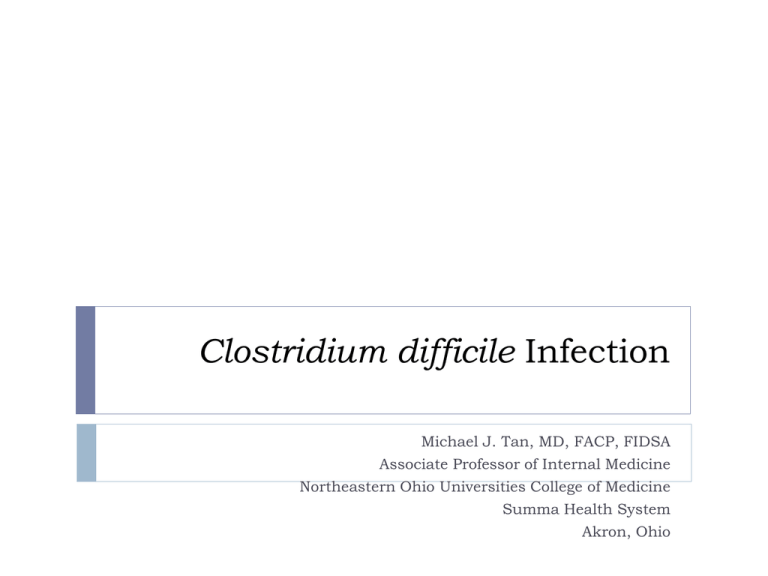
Clostridium difficile Infection Michael J. Tan, MD, FACP, FIDSA Associate Professor of Internal Medicine Northeastern Ohio Universities College of Medicine Summa Health System Akron, Ohio Objectives Review common challenging aspects treating diarrhea in the era of epidemic Clostridium difficile infection: Treatment/Management Diagnosis New and emerging therapies In a patient with liquid stool, which of the following would be most suggestive of nonC. difficile diarrhea A. Negative stool C difficle toxins x3 B. Single negative C difficile common antigen C. Single Positive C difficile Common antigen with negative C difficile toxin D. Negative fecal leukocytes E. Negative stool lactoferrin History 1893 Pseudomembranous colitis first described as “Diphtheritic colitis”. Finney Bull Johns Hopkins Hosp 1935 Bacillus difficilis isolated from feces of newborns. Hall & O’Toole Am J Dis Child 1950s+ Colitis was attributed to staphylococcus aureus. 1960 Doubt cast on above…S. aureus not always found. Dearing Gastroenterology 1974 Clindamycin-associated colitis. Tedesco. Ann Intern Med 1977 Undescribed toxin in pseudomembranous colitis. Larson. Br Med J 1977 Antibiotic-induced colitis. Implication of a toxin neutralized by Clostridium sordellii antitoxin. Rifkin. Lancet 1977 Clindamycin associated colitis in hamsters: protection with vancomycin. Bartlett. Gastroenterology 1978 Identification of Clostridium difficile as a cause of pseudomembranous colitis. George. Br Med J 2000s S aureus may cause disease like C. difficile. Case A 70 year old female is admitted to your service with liquid stool seven times a day. You are seeing her for the first time, and she has no orders entered yet. Which of the following is the most appropriate next step? A. Start on oral vancomycin 125mg PO q6h B. Start on oral metronidazole 500mg PO q8h C. C difficile Common Antigen D. Take more history E. Call ID History She was recently treated with a course of amox/clav x 7 days for “bronchitis” She just finished her last dose the morning of admission She usually has one soft stool daily On amox/clav she went 3-4x/day mushy Now stool is 7x/day mostly liquid She has some abdominal discomfort She’s still tolerating P WBC is 16k Crt 1.6 What to do now? A. Start metronidazole 500mg PO q8h B. Start metronidazole 500mg IV q6h and Vancomycin 125mg PO q6h C. Start vancomycin 125mg PO q6h and order C difficile assay D. Order C difficile assay, await result before starting E. Start a bulk-forming agent What is this common antigen test? Toxin test as a test of cure? Sensitivity of Toxin EIA 70-80% Common antigen very sensitive, but can’t differentiate between toxin producing and non-toxin producing If a Common Antigen is negative, negative predictive value about >98%, probably NOT CDI. Screen with common antigen. Use toxin to confirm. Negative toxin won’t rule out CDI. Diagnostic Aids Toxin Assay Toxin A/B – Both Fast, but less sensitive than stool culture Need to combine with toxin assay Slow and labor intensive but sensitive Growth may not be toxigenic strain May be gaining favor for detection of toxigenic C. difficile Will need high sensitivity and specificity Antigen detection Stool cultures PCR Colonoscopy with biopsy Abdominal CT Scan Clinical suspicion History/epidemiology Lactoferrin? Testing methods Classically C. difficile A/B toxin testing Culture is gold standard Sensitivity is about 80% (70%-90%) Slow and labor intensive IDSA doesn’t make a firm recommendation on which approach to use. Two-Step testing approach Test with Common Ag If (-) extremely unlikely C Diff If (+) test for cytotoxin If Cytotoxin (+) C Dif If Cytotoxin (-) clinical judgement Cytotoxin testing not widely available Two step common Ag + Toxin A/B Testing principles-Update Common Antigen Do only once, repeat only if stools change + Common, - toxin, same boat as before; clinical judgment should be exercised Toxin If the first one is negative, it’s still not likely to be CDAD. Don’t go beyond two. Don’t test formed stools. Test only if liquid. Still NOT recommended as test of cure. Risk of asymptomatic colonization. Is metronidazole still effective? Metronidazole is still acceptable as first line therapy for MILD disease Metronidazole 500mg PO q8h or 500mg IV q6h Vancomycin preferred for anything other than mild disease No data to show that 250mg or 500mg of vancomycin better than 125mg PO q6h. May have better toxin clearing, but no evidence of morbidity or mortality improvement. Vancomycin or metronidazole? If Severe, vancomycin Age > 65 Multiple comorbid conditions Abdominal symptoms, peritonitis, radiographic findings Leukocytosis >15k Sepsis syndrome (Pretty much anyone who can get admitted) If Unable to PO, metronidazole 500mg IV q6h No proven benefit of vancomycin PO + metronidazole IV/PO Treatment Stop antibiotics if possible For first time positive of mild disease Metronidazole 500mg PO q8h Alternative Vancomycin 125mg PO q6h Treatment generally 10-14d Severe Disease Metronidazole 500mg IV q6hr if unable to PO Vancomycin 125mg PO q6h Metronidazole 500mg IV q6hr if unable to PO Treatment generally 10-14d Generally No benefit of combining metronidazole and vancomycin No benefit of 250mg or 500mg of Vanc PO vs. 125mg Case Vancomycin 125mg PO q6h started on hospital day #1 Day 2-3, WBC improves, creatinine improves Day 3-4, little stool Day 5: Big loose, semi-formed BM, creat and WBC stable Which of the following is reasonable? A. Increase vancomycin to 250mg PO q6h B. Recheck stool C difficile assay C. This happens…continue therapy as current. D. Add lactobacillus and saccharomyces E. ID Consult Epidemic strain Not generally more resistant to vancomycin or metronidazole Baines: JAC 2008 Aug 7, Emergence of reduced susceptibility to metronidazole in C difficile. Interestingly for 001 ribotype England, NOT 027!! Can be more difficult to treat Can take longer to respond to therapy Response to treatment Epidemic strain C Diff may take longer to respond to therapy Patients should be given 3-5 days on therapy with no improvement before being considered a treatment failure Any improvement in stool frequency, consistency, leukocytosis or abdominal pain is improvement Not uncommon for patients to improve to not having any stool, but then have a huge stool around this time Epidemiology 10-20% of inpatients on antibiotics develop diarrhea 20% of these from C. diff. Bartlett NEJM 2002, Cleary Dis Colon Rectum 1998 Mortality 6-30% when pseudomembranous colitis is present 1% of hospitalized patients develop CDAD 20% of cases are community acquired Buchner Am J Gastro2001, Dallal Annals Surgery 2002. Epidemiology CDAD continues to rise Discharge data: Disproportionately affects patients over 65 Attributable mortality direct and indirect up 7%/17% 253 000 hospitalizations affected by CDAD 2005 Rate is doubled that of 2000 Classic attributable mortality <1% Cost Hospital costs (1990s) $2000-$5000 Mean lifetime cost $11000 Epidemiology Higher readmission rates Higher rates of patients to LTAC Number and rate increased 5-fold on death certificates between 1999 and 2004 Previously low-risk patients are at risk Pregnant and community onset patients are increasingly common, including lack of antibiotics More than half the states have Epidemic strain States with BI/NAP1/027 strain of C. difficile (N=40), October, 2008 DC HI AK CDC PR Epidemiology Dubberke E., et al, Arch Intern Med. 2007;167:1092-1097 Wards with more CDAD patients had higher risk of patients developing CDAD Association almost as strong as antibiotic use MSNBC/Dr. Curtis Donskey Case You made no change to her therapy. Day 6-7, stools back to 1-3x/day, soft but “not perfect”. Feels better, hoping for discharge. What next? A. Plan discharge and finish14 day course of vancomycin 125mg PO B. Recheck C difficle assays C. Add lactobacillus and/or saccharomyces therapy D. Stop PO Vancomycin and Discharge E. Consult ID. She still has diarrhea. Case Patient was discharged, and she finished 14 days of PO Vancomycin. After finishing the PO vancomycin, her stools returned to 1x/day, soft. Five days later you get a call…she has diarrhea. What next? A. Restart Vancomycin 125mg PO q6h B. Start Vancomycin 250mg PO q6h C. Start metronidazole 500mg PO q8h D. Get more history E. Repeat C difficile assay History Further history reveals that the patient is now having 34BM/day, soft and mushy, not liquid like it was when she was admitted. Eating ok, no abdominal pain. Next? A. Restart the Vancomycin 125mg PO q6h B. Start Vancomycin 250mg PO q6h C. Probably not C difficile recurrence, watch the stool a little longer D. Recheck the C difficile assay E. Start a bulking agent. Is this Recurrence or post-CDI irritable bowel? Get down to the nature of the stool Is it… Liquid? Any form in it? >5x/day Like it was before therapy? Better than it was before therapy but worse than baseline? Most stool that is better than it was before therapy, but worse than baseline is likely post-CDI IBS Usually does not require treatment Treatment indicated, if it does go back to what it was before treatment Reservoirs and Colonization McFarland NEJM 1989, JID 1990 Asymptomatic colonization 15-70% of neonates. (<=1 yr) < 5% of normal adults 20% after 1 wk in hospital 50% after >4 wks in hospital 30% of newly colonized patients develop CDAD There is a greater chance of positive common antigen or positive toxin that is not representative or disease. Clinical presentation is key extremely important Case You elected to observe the patient. Her stools calmed to a1-2x/day, soft and mushy, but 10 days after her last dose of PO Vanc, she has 6 stools in one day that are liquidy. She thinks she overdid the tacos, and she doesn’t call until day 12. Now her stools are 1-2/day again. What do you do? A. Restart the Vancomycin 125mg PO q6h B. Start Vancomycin 250mg PO q6h C. Probably not C difficile recurrence, watch the stool a little longer D. Recheck the C difficile assay E. Start a bulking agent. Case Day 15 post-therapy: On day 14 and 15, she’s been having 7-8 liquid stools per day. What now? A. Restart vancomycin 125mg PO q6h x 14 days B. Restart vancomycin 250mg PO q6h x 14 days C. Not likely a recurrence, watch a little longer D. Start a bulking agent E. Add probiotic therapy How do I treat a recurrence? Is it really a recurrence? Recurrence usually in first 14 days after therapy Recurrence rate is about 20% of metronidazole or vanco Same course is usually indicated for first recurrence May advocate going to vancomycin if previously on metronidazole Second Recurrence 14-3-14 days? 28 days? Taper? Treatment Second Recurrence If continued response, same drug is appropriate—but would advocate using vancomycin instead Many strategies 14 days on 3 days off, 14 days on Extended duration, 28 days Change medication Vancomycin Tapers Flagyl absorption/transit failure with improved symptoms? How do I treat a recurrence? Multiple recurrences No standard set Multiple drugs Ask a consultant Verify it’s actually CDI Colonscopy Rule out Inflammatory bowel S. aureus Fungal overgrowth, bacterial overgrowth syndrome? Rule out other medication induced. Probiotics have a limited role Therapy must be individualized Binders, bulk-formers not of any benefit Fecal transplant? Follow-up studies in refractory patients Look for other causes Culture for S. aureus Fungal Overgrowth/Overgrowth Syndrome? Get another colonoscopy Inflammatory bowel IgG if possible IgG to toxin A Other history Colectomy/Bowel Surgery Medications/Probiotics What goes in affects what comes out What preventive measures can be taken? Prophylactic CDI therapies? Prophylactic probiotics? Probiotics and Prophylaxis There are no good randomized clinical trials that suggest probiotics have any beneficial effect There are many cases of lactobacillus bacteremia and saccharomyces fungemia “Prophylaxis” with these agents has not demonstrated fewer CDAD cases “Prophylaxis” with metronidazole or vancomycin has not been shown to be effective A recent meta analysis of studies suggests some benefit of Lactobacillus rhamnosus for AAD but not CDAD and Saccharomyces boulardii for CDAD recurrences. (Am J Gastroenterol.101 (4):812–822 (2006) McFarland LV Meta-Analysis of Probiotics for the Prevention of Antibiotic Associated Diarrhea and the Treatment of Clostridium difficile Disease) BMJ 335:80 (2007) Hickson et al, Efficacy with a Lactobacillus preparation for prevention of diarrhea. Does have methodological flaws Kale-Pradhan et al, Pharmacotherapy 2010;30(2); 119-126. Role of Lactobacillus in the Prevention of Antibiotic-Associated Diarrhea: A meta-analysis. Data heavy from one particular paper; suspect at best Other probiotic preps are under investigation What about these? Probiotics – NOT definitively helpful. Have been documented cases of lactobacillus bacteremia and Saccharomyces fungemia Lactobacillus Saccharomyces Acidophilus Bacitracin – as effective as vancomycin, but higher residual toxin without more evidence of recurrent colitis Cholestyramine – NOT demonstrated to be helpful. Runs risk of binding other agents Is there going to be anything that works better? Yes and No Therapeutics Accepted Metronidazole Vancomycin PO Controversial Some studied success Nitazoxanide Rifaximin Tinidazole Bacitracin Ramoplanin Probiotics Cholestyramine IVIG Vancomycin retention enema Stool transplant Research compounds Tolevamer (failed) MBL-monoclonal Ab. A & B OPT-80 (Fidaxomicin) Lipoglycopeptide? Vaccine? MDX-066 (CDA-1) and MDX-1388 (CDB-1) Phase II Completed Human antibody-based monoclonal antibodies to neutralize CDTA/CDTB 11/3/2008 Standard of care (metro vs. vanco) + MAb vs. placebo one time infusion. Placebo recurrence rate 20%, consistent with literature MAb recurrence rate reduced 70% compared with placebo Medarex/Massachusetts Biologic Laboratories Press Release, 11/3/2008 OPT-80-fidaxomicin One of Two Phase 3 trials completed 10 days OPT-80 vs. vancomycin PO Similar Cure rates compared with vancomycin 92.1% vs 89.9% Lower recurrence rates compared with vancomycin, 13.3% vs 24% Global Cure rates higher compared with vancomycin, 77.7% vs. 67.1% Second Phase 3 trial just finished Newest data As above, but recurrence rate similar to vancomycin when dealing with epidemic strain Second Phase 3 complete with similar results; Epidemic strain data still pending. Optimer Pharmaceuticals Press Release 11/10/2008 Outpatient Diarrhea Get a full history Get down to the poop Medication history Abx associated diarrhea medications Other laxatives/cathartics OTC/Natural remedies Travel History Activities Dining History Sick Contacts Duration/Recurrence Outpatient diarrhea Stool Ova and Parasite Stool culture Salmonella, Shigella,Yersinia, Campy Immunecompromised Giardia Modified Acid-fast stains for “-sporidosis” C Difficile assays Outpatient Diarrhea Base CDI therapy on index of suspicion Base any diarrhea therapy on index of suspicion Non-toxic and controllable stools? It’s ok to observe without therapy! Inpatient Diarrhea Get a full history Get down to the poop Medication history Start prior to or after admission? Abx associated diarrhea medications Other laxatives/cathartics/tube feeds OTC/Natural remedies Duration/Recurrence Some of the outpatient questions apply too Inpatient diarrhea Stool Ova and Parasite Stool culture Salmonella, Shigella,Yersinia, Campy Immunecompromised Generally don’t check unless admitted <48h and diarrhea started prior to admit Modified Acid-fast stains for “-sporidosis” C Difficile assays Fecal WBC, lactoferrin? Inpatient Diarrhea Base CDI therapy on index of suspicion Base any diarrhea therapy on index of suspicion Doesn’t sound quite like CDI, and the stool is controllable, and the patient is “stable?” It’s ok to observe without therapy! Have a threshold to start. Is it ok to use a bulk-former? Generally bulk-formers of little benefit If fairly certain CDI is not active, ie Post-CDI irritable bowel Probably ok to use bulk-former Probably ok to use gut slowing agent But monitor closely for recurrence or worsening Summary Test stool where suspicion is high Do not treat asymptomatic disease Epidemic strains appear to produce more toxin Epidemic strains are more virulent, but not resistant Single recurrence does not indicate resistance Vancomycin PO is preferred for severe disease Metronidazole is still first line for mild disease Surgical intervention indicated for severe cases/megacolon/obstruction Pursue other causes if CDAD evaluation continues to be negative Image courtesy of M Tan, used with permission
